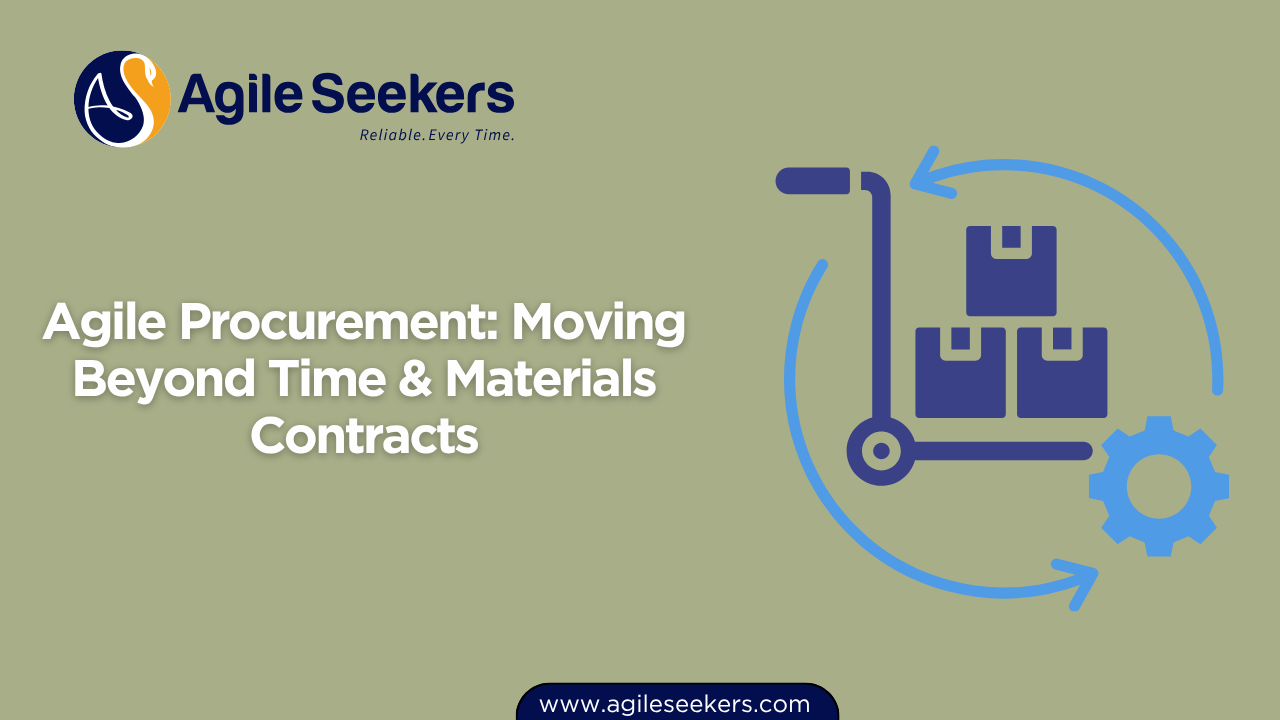Agile Procurement: Moving Beyond Time & Materials Contracts

Procurement in traditional IT and software delivery models often falls into a predictable trap: scope, schedule, and cost get locked early, long before teams fully understand the problem or its solution. Time and Materials (T&M) contracts attempted to bring more flexibility, but they still suffer from inherent inefficiencies in Agile environments. In contrast, Agile procurement aims to create a partnership based on shared outcomes, transparency, and adaptive collaboration.
This post explores how Agile procurement challenges the outdated reliance on T&M contracts, how it drives real value delivery, and what organizations need to shift structurally and culturally.
Why Time & Materials Contracts Fall Short
T&M contracts are built on a simple idea: the customer pays for the hours worked. This structure assumes ongoing requirements volatility, but it doesn't solve the underlying problem—misaligned incentives.
Key limitations of T&M contracts in Agile environments:
-
No direct link to value: Teams are paid for effort, not outcomes. This makes it harder to measure ROI.
-
Accountability dilution: Suppliers may optimize for billable hours rather than rapid value delivery.
-
Lack of built-in feedback loops: T&M contracts rarely include built-in milestones or checkpoints based on business value or product increments.
-
Procurement friction: Frequent change requests, renegotiations, and governance overhead reduce team agility.
While better than rigid fixed-price models, T&M still prioritizes the vendor's input over the customer’s outcome.
Agile Procurement: Shifting to Outcome-Based Collaboration
Agile procurement focuses on enabling Lean-Agile delivery by aligning procurement practices with incremental value delivery. It shifts the mindset from “buying work” to “partnering for outcomes.”
This shift is grounded in principles such as transparency, trust, and adaptability—tenets also found in the Leading SAFe® certification training which emphasizes Lean-Agile leadership at scale.
Key characteristics of Agile procurement:
-
Co-creation over control: Buyers and suppliers collaborate on scope evolution, rather than fixing it upfront.
-
Outcome-based contracting: Agreements define success in terms of working software and business value, not effort logged.
-
Incremental funding: Budgets are released iteratively, based on evidence of learning and progress.
-
Shared risk and reward: Performance-based incentives motivate vendors to focus on results rather than hours.
A model example is the Managed Investment Contract within the SAFe framework, where customers fund a solution incrementally and reassess continuously. This allows for learning, pivoting, or even halting low-value initiatives.
Comparing Time & Materials vs Agile Contracts
Here’s a practical comparison:
| Aspect | Time & Materials Contracts | Agile Contracts |
|---|---|---|
| Scope | Emerges but loosely governed | Evolves collaboratively with each increment |
| Billing | Hours or effort | Business value delivered or milestones met |
| Incentives | Maximize billable time | Deliver working, valuable solutions |
| Risk | Customer bears most risk | Risk shared across stakeholders |
| Governance | Change control boards, formal approvals | Lean budgeting, decentralized decisions |
Agile contracts better support continuous delivery models, such as those taught in SAFe Scrum Master Certification, where flow and transparency are crucial.
How to Adopt Agile Procurement in Practice
Transitioning from legacy procurement to Agile models requires a combination of process reengineering, mindset shifts, and cross-functional education.
1. Engage Procurement Early in the Agile Journey
Often, procurement is treated as a late-stage activity. Instead, integrate them from the start of Lean Portfolio Management conversations. Frameworks like SAFe® Release Train Engineer (RTE) training highlight the importance of aligning finance, governance, and delivery.
2. Define Value Collaboratively
Agile procurement requires stakeholders—business owners, product managers, finance, and legal—to define value upfront and revisit it iteratively. The SAFe POPM Certification helps professionals build this outcome-focused mindset and structure backlogs accordingly.
3. Move to Lean Contracting Models
Agreements should support shorter cycles, empirical feedback, and rapid realignment. Consider including clauses for:
-
Incremental scope decisions
-
Termination flexibility
-
Shared key performance indicators (KPIs)
Legal teams need to understand how Agile governance differs from traditional models—especially in areas like compliance, vendor performance, and deliverable inspection.
4. Pilot Agile Contracts with Trusted Vendors
Start small. Run a single Agile program with a known vendor using outcome-based metrics and adaptive funding. Capture learnings and iterate before scaling.
This approach aligns well with principles discussed in SAFe Advanced Scrum Master Certification, where facilitation and cross-boundary coordination are critical.
Benefits of Agile Procurement
Organizations that successfully implement Agile procurement unlock a set of advantages beyond simple cost control:
-
Higher product-market fit: Continuous validation allows better responsiveness to user needs.
-
Improved speed to value: Short feedback loops and adaptive funding reduce waste.
-
Greater alignment across stakeholders: Transparency in contracts brings legal, finance, and delivery onto the same page.
-
Increased vendor accountability: Shared goals encourage suppliers to act as partners, not just contractors.
Real-World Example: Public Sector Agile Procurement
Agencies like the U.S. Digital Service and UK Government Digital Service have adopted Agile procurement successfully. Their strategies include publishing open RFPs for capability, not fixed scope, and engaging vendors in short discovery sprints before full engagement. You can explore more in this external Agile procurement case study{:target="_blank" rel="noopener"}.
These models show that even in highly regulated environments, Agile procurement can thrive with the right structure and intent.
Final Thoughts
Agile procurement represents more than a contractual tweak—it’s a strategic realignment. Organizations that move beyond T&M contracts and embrace adaptive, outcome-driven agreements stand to gain better solutions, stronger vendor relationships, and a real edge in delivering customer value.
To enable this transformation, professionals must upskill across Agile roles—from Scrum Masters and Product Managers to RTEs and Lean Portfolio leaders. AgileSeekers offers leading training programs such as:
-
Leading SAFe® Certification Training for decision-makers and enterprise leaders
-
SAFe Scrum Master Certification for team-level agility
-
SAFe POPM Certification for outcome-focused backlog ownership
-
SAFe RTE Certification for end-to-end Agile Program execution
Agile procurement isn’t the future—it’s what agility demands now.
Also read - Introducing the SAFe “Managed‑Investment Contract”




















